Amazon horned frogs, also known as Surinam horned frogs, are one of the largest amphibians in South America’s Amazon Basin.
The frogs get their name from their distinctive horn-like projections sitting on top of their eyes. These help camouflage the frogs in their natural habitats while giving them an intimidating appearance.
These unique amphibians are known for their aggressive behavior. They’re solitary and violently fight to defend their territories against intruders.
Moreover, they’re voracious carnivores that eat just anything that fits in their mouth!
Despite being big and aggressive, these frogs face numerous threats in the wild including habitat loss, pet trade, etc., which impact their numbers in the wild.
It’s, therefore, important to study the frog natural history, behavior, biology, and physical characteristics to help us better understand them and conserve them for future generations.
This article comprehensively everything you need to know about the Amazon horned frogs, including their physical characteristics, habitat, behavior, natural history, and conservation status.
Species name:
- Common name: Amazonian horned frog, Surinam horned frog
- Scientific name: Ceratophrys cornuta
Classification:
- Family: Ceratophryidae
- Genus: Ceratophrys
- Species: cornuta
Physical Characteristics
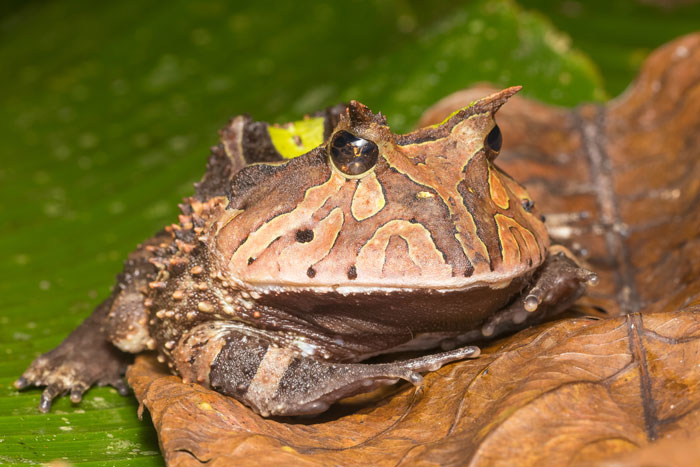
Amazon horned frogs are fairly large, with adults growing to an average of 4 to 8 inches.
Females usually grow larger than males, just like in other frogs. Adult males weigh up to 60g while females are 130g heavy!
Probably the most distinguishing feature of these frogs is the horns sitting above thing eyes. They also have a rounded body with a prominent head. They also have large mouths.
Besides small size, you can easily identify males from females by the nuptial pads on their fingers.
Coloration and markings:
Coloration of these frogs ranges from lime to dark green or tan. Male frogs may display all these 3 colors at the same time while females are usually tan.
The underside of these frogs is gray while the mouth is white.
Amazon horned frogs’ limbs appear shorter, with dark color bands. Thighs appear brownish with yellow spots. The frogs’ skin bears small, pointy warts.
Different South American frog species:
There are 25000plus frog species inhabiting South America besides the Amazon horned frog species. Some other common frog species you’ll find here include the fascinating glass frogs, tree frogs, and poison dart frogs, to name but a few.
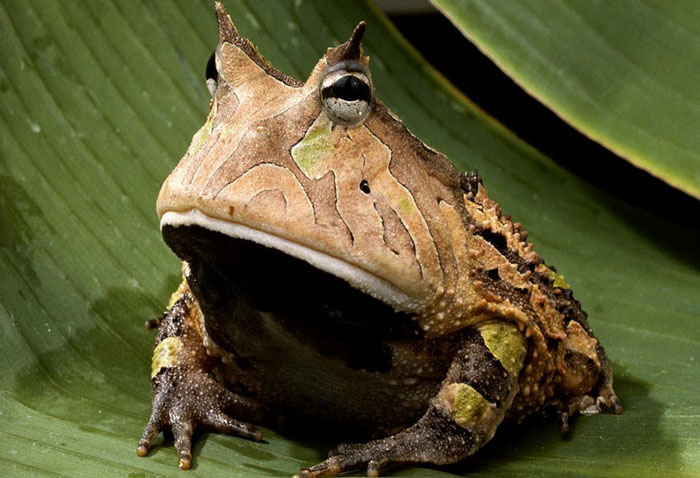
The closest relatives to Amazon horned frog inhabiting South America include: Colombian horned frog, Brazilian horned frog, Cranwell’s horned frog, Argentine horned frog, Ecuador horned frog, and Stolzmann’s horned frog.
Unique Adaptations:
Just like other frogs inhabiting the Amazon Basin, Amazon horned frogs have developed several morphological adaptations to enable them to survive in their environments.
For instance, the frogs have cryptic coloration, with males’ coloration ranging from lime to dark green (and tan for females). This enables them to blend in with their surroundings and avoid detection by predators or prey.
Though scientists are still unraveling the purpose of horns in the frogs, they’re believed to help camouflage these frogs as they resemble leaf stalks in the wild.
Their thick and warty skins help these frogs retain moisture during dry seasons.
Amazonian horned frogs also have large mouths and powerful jaws. You enable them to swallow even larger prey easily.
Habitat and Behavior
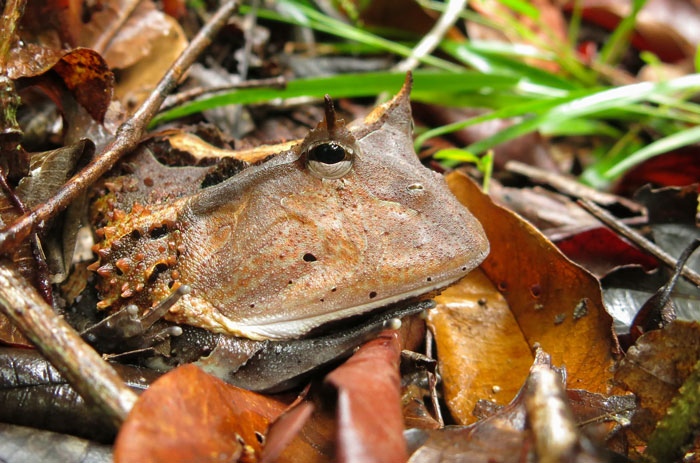
Amazon horned frogs are endemic to South America. Specifically, they inhabit the Amazonian Basin of Ecuador, Colombia, Guianas, Bolivia, Peru, Venezuela, and Brazil.
The frogs live in forest areas and are mostly found in leaves of forest floors. The frogs prefer areas with moderate to high temperatures and high humidity levels.
They’re terrestrial but prefer living near freshwater pools and marshes within old forest areas.
Nocturnal behavior:
These frogs are primarily and will only come out at night to hunt and breed.
During the day, they prefer to hide under burrows and leaf litter on the forest floor to avoid excessive warmth as well as avoid predation.
To hunt prey, they simply burrow in leaves on the forest floor and only stick out their heads. They then wait for anything edible to pass by and grab it.
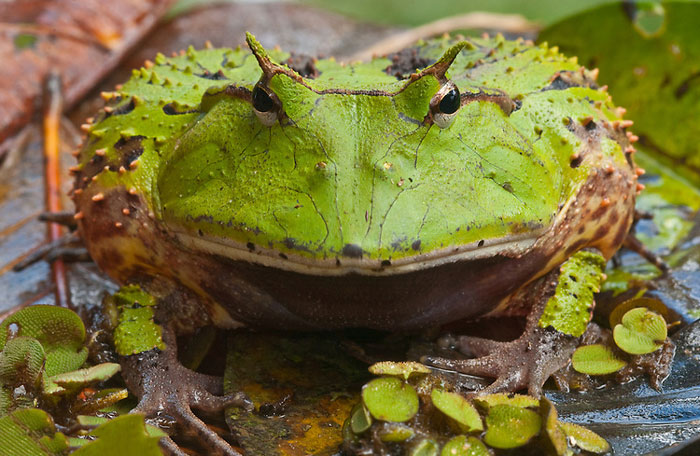
Solitary and territorial behavior:
Surinam horned frogs are solitary. They can also show territorial behavior when fully grown up. The males can turn vigorously aggressive toward each other as they try to defend their territories from intruders.
Biologists believe that this territorial behavior could be caused by scarcity of suitable frog habitats in the rainforest ecosystems and the need for the frogs to secure key resources like water and food.
Communication:
These unique frogs use vocalizations when trying to communicate with fellow frogs.
This is evident during the mating season when males gather in groups and emit a noisy bleating sound to attract females.
Tactile communication has also been observed in these frogs during the mating period.
Breeding and mating behavior:
Amazon horned frogs reach sexual maturity around the age of 3 to 4 years old.
The frogs mate seasonally, and both males and females appear to be polygamous. Mating occurs in temporary pools that form after rainfall.
The beginning of the breeding period involves the males gathering in suitable mating sites and then calling females.
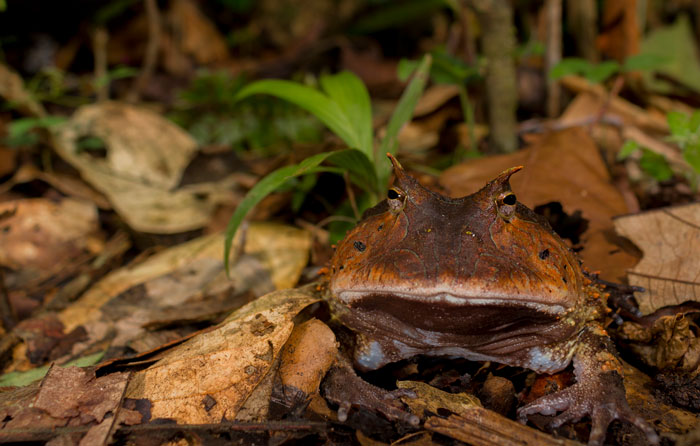
Once the females show up and mating occurs, the female lays eggs as the male fertilizes them externally.
Despite the large size of these frogs, they lay a small number of eggs—around 300 to 600 eggs per clutch.
Once the mating occurs and the eggs are fertilized, males put them at the females’ backs. The females then move around looking for suitable sites for the embryos to develop.
Tadpole development:
The eggs take anywhere from 3 to 25 days to hatch into tadpoles. Once they emerge, the tadpoles undergo metamorphosis in around 90 days to become froglets.
Parental care:
Female Amazon horned frogs show some level of parental care by selecting a suitable site for depositing their fertilized eggs. They also supply the eggs with plenty of nutrition needed for proper embryo development. However, once the eggs are deposited, neither she nor the male shows any additional involvement with the tadpoles.
Natural History
Amazon horned frogs play a vital role in the rainforest ecosystem and are crucial for maintaining the health and balance of their ecosystems.
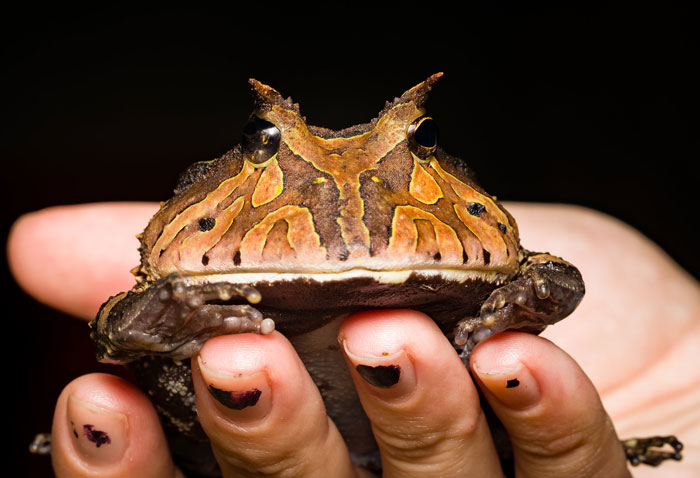
Controlling populations of species in their ecosystem:
One of the roles these frogs play is controlling the population of other animals in the ecosystem by preying on them, thus keeping the ecosystem balanced.
These frogs are not picky feeders and will eat anything that fits their mouth (which explains their fat nature). They feed on a wide variety of animals in their natural habitat including insects, spiders, small invertebrates, and other frogs.
Predation:
Other animals in their ecosystem also prey upon these frogs. Examples of predators include birds of prey, snakes, bears, and even other amphibians. However, the aggressive behavior and large size of these make them not have many predators.
Challenges and opportunities of studying the frogs:
When studying these frogs, biologists usually face many challenges. For instance, these frogs are hard to see in the wild due to their nocturnal behavior, aggressive nature, and elusive behavior. This can make it quite hard to understand their complex behaviors as well as their interactions with other animals in their natural habitats.
Nonetheless, we cannot deny how important these animals are to their rainforest habitats. As such, there is a need to study them to better understand their natural history.
Studying the Amazon horned frog behavior, ecology, physical characteristics, habitat, predator-prey interactions etc., can help us appreciate this creature better.
This way, we can take part in various conservation efforts aimed at protecting and preserving the frogs for future generations.
Conservation Status
The Amazon horned frog conservation status on IUCN Red List is “Least Concern“, meaning its populations are currently stable.
However, we should be concerned about this frog’s survivability due to the multiple threats it faces in the Amazon horned frog habitat in the wild.
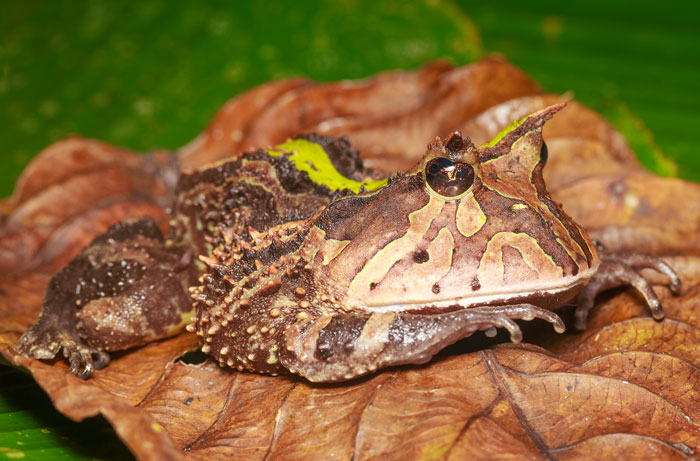
Most of these threats are attributed to human activities and environmental changes. They include:
- One of the biggest threats these frogs face is habitat loss. This has a lot to do with human activities such as deforestation, urbanization, and agriculture.
The rainforests continue to be cleared to make way for human development projects. And this leaves the frogs with limited areas to live in, with limited resources.
- Another threat these frogs face is climate change, which alters rainfall and temperature patterns. This directly affects the frogs’ natural ecosystems, making the resources they need to survive and reproduce scarce.
- Collection in the wild for pet trade is another problem that impacts the population of these fogs in the wild.
Conservation efforts to protect Amazon horned frog:
Conservation organizations should come up with necessary measures to help protect these frogs and their habitats.
One of the suggested measures is increased research into the frog ecology, behavior, interaction with other animals, and threats it faces.
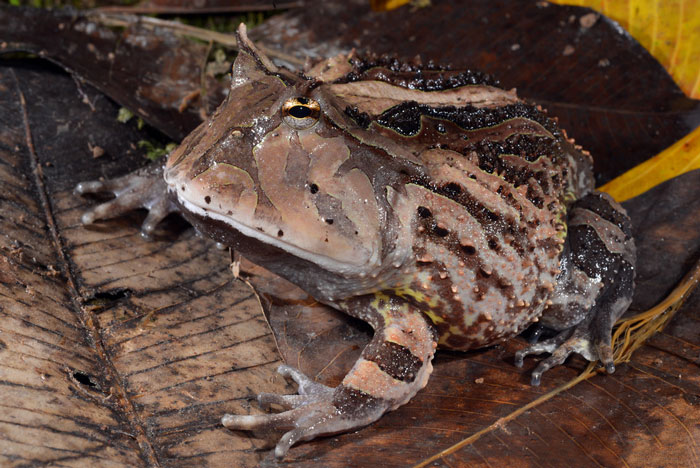
The study can provide research institutions and biologists with key insights for creating more effective consecration strategies for these frogs.
Another effective way to protect these animals is by implementing habitat preservation programs to protect the areas where these frogs live.
For instance, governments of various countries where Amazon horned frogs live should consider creating protected areas like reserves and national parks.
These will help convert these frogs and keep them safe from human activities.
Legal protection of Amazon horned frogs is also crucial to promoting their survivability. This includes stopping collection from the wild and making available captive-bred populations for use as pets.
Why these conservation efforts are necessary:
Conservation of these frogs is essential to ensuring the survival and health of their ecosystems. The frogs play a critical role in keeping the ecosystems balanced. If they become extinct, the ecosystems and other animals that depend on them (the ecosystems) will be greatly impacted.
Interesting Facts
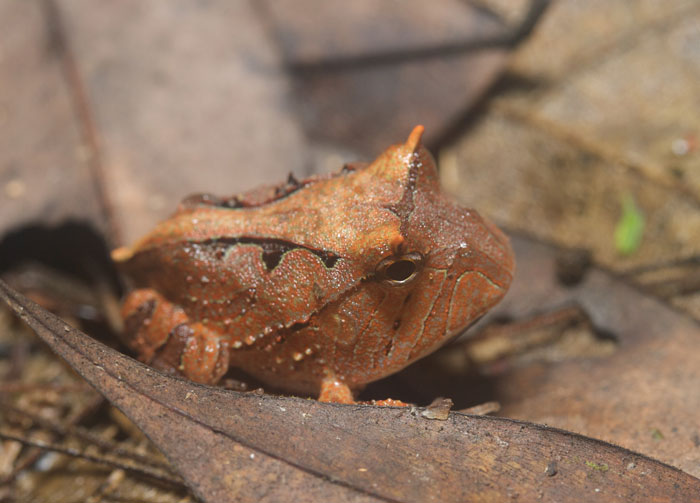
Here are some little-known, interesting facts about Amazon horned frogs:
- Amazon horned frogs are aggressive animals and can eat anything that fits in their mouths, including other frogs.
- The horns in the Amazon horned frogs are believed to help camouflage the frogs against detection by predators and prey. They can resemble something completely different like leaf stems in the frog’s surroundings.
- The frogs have an average lifespan of 10 years, which can be longer (up to 15 years) in captivity.
- Male Amazon horned frogs are known to produce incredibly loud mating calls that can be heard up to a quarter mile away in their natural habitats.
Conclusion
Amazon horned frogs are unique amphibians that are easily recognized by their horn-like projections. This article has just discussed everything you need to know about these frogs, including the Amazon horned frog physical characteristics, habitat, behavior, predators, animals it preys on, adaptations to survive in the wild, and conservation status.
Although the populations of these frogs currently seem stable, they are facing numerous threats such as habitat loss, climate change, and over-collection for the pet trade. All these can affect their populations and even drive them to extinction in the future.
Continued research and conservation efforts for these frogs are essential to ensure we protect their population and the ecosystems they inhabit.

Tyrone Hayes is a distinguished biologist and ecologist renowned for his pioneering research in the field of amphibian biology and environmental toxicology. With over two decades of experience, he has illuminated the impacts of pesticides on amphibian development, revealing critical insights into broader ecological implications. Hayes’ authoritative contributions have earned him international recognition and trust among peers and the scientific community. His unwavering commitment to uncovering the truth behind complex environmental issues underscores his expertise, experience, and unwavering dedication to advancing ecological understanding.
